|
Lock Street to Cannock Road This part of
the canal had two factories on the western side,
Junction Iron Works and Cannock Road Works. The area
between the two was occupied by Herbert Street Goods
Depot, which was covered in part 6.
On the eastern side of the canal are two railway
lines. The western one was built by the Shrewsbury &
Birmingham Railway Company, and taken over by the
London & North Western Railway. The other was built
by the Great Western Railway.
The old North Western line is still in use today,
whereas the Great Western line closed in the 1960s.
On the right is Springfield Brewery that had a
siding from the Great Western main line.
There are 4 locks on this part of the canal, lock
2 to lock 5. |
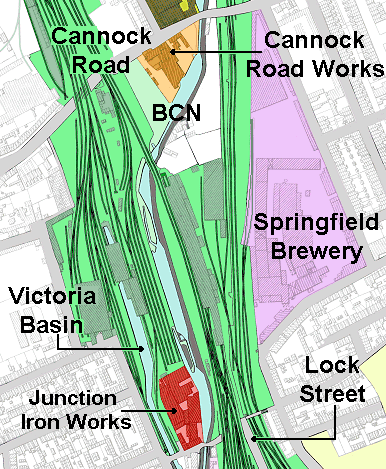 |
Junction Iron Works In Littles Lane beside the
canal stood Junction Works, where cut nails and
shoe tips were made. The business is listed in
Pigot & Company’s 1842 Staffordshire Directory
as Junction Works, cut nails and shoe tips. In
the 1845 directory the listing is as follows:
Joseph Walker, heel tip and cut nail
manufacturer, Junction Works.
|
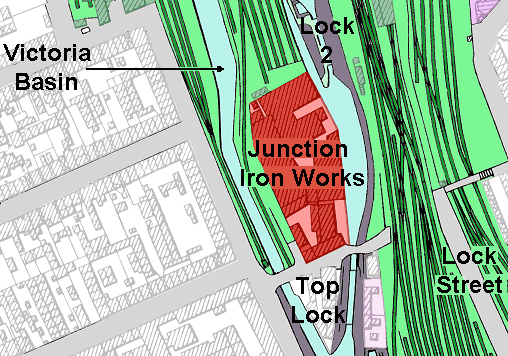 |
In between the factory and
Lock 2 was a basin, which must have been used to
unload the sheet steel that fed the firm’s
presses. The basin would also have been used to
load bags of cut nails and shoe tips onto
waiting boats to be transported to customers.
In 1848 to 1849 Victoria Basin
was built by the Shrewsbury & Birmingham Railway
Company as part of their new goods station.
Junction Works were then situated on a thin
strip of land between the main canal and
Victoria Basin. |
| Just left of lock 2 is
what remains of the basin that was used by the
works. It is now
overgrown. |
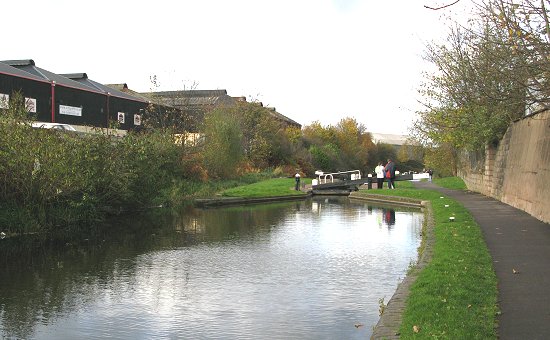 |
|
White’s 1851 Staffordshire
Directory lists Joseph Walker as a cut nail maker in Littles Lane.
The factory is marked on the 1901 Ordnance
Survey map as Junction Works, cut nails and shoe
tips, but is marked as disused on the 1919 map,
so the business must have closed by then. The
site was later acquired by the Great Western Railway for an
extension to the goods station. |
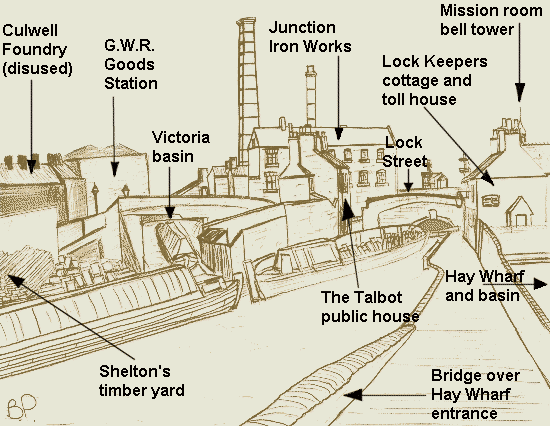
An impression of how Junction Works must
have looked in about 1900.
| Cannock Road
Wharves and Cannock Road Works By 1851 the
site had been occupied by the
Shropshire Union Railways and Canal Company who
had two wharves, a large one roughly in the centre
of the site, and a smaller one to the north. The
company is listed in White's 1851 Staffordshire
directory as follows: The Shropshire Union
Railways & Canal Company, Cannock Road. R. K.
Shenklin agent. In 1870 the company built Broad
Street Warehouse, and moved from Cannock Road to the
new premises. The Cannock Road site was sold by
auction in 1870, as a site with extensive
warehouses, and wharfage land. |
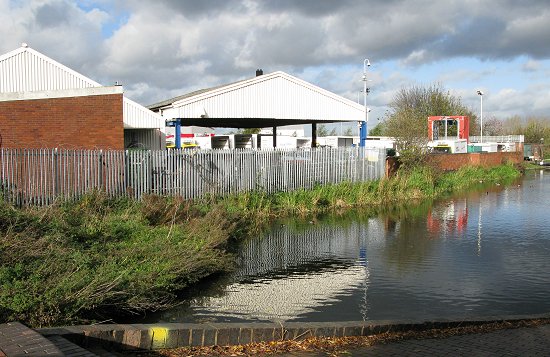 |
The site today, as seen
from lock 4.
The large basin was in the
centre, where the building now stands. |
| Another modern view
looking towards lock 5.
The narrow basin was on the
extreme left. |
 |
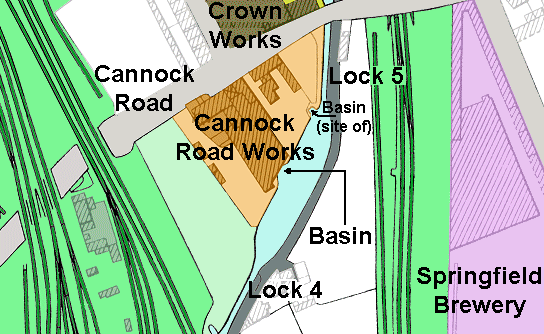 |
A map showing Cannock
Road Works, and the two basins.
The northern basin had
been filled-in before the factory was built. |
|
G. R. Smithson & Company Limited.
It appears that the site was purchased by
Smithsons in the 1890s when the factory was
built.
The company, founded in 1888 were originally
japanners, but changed direction to produce a
wide variety of small pressings, presumably when
Cannock Road Works was built.
Pressings of all kinds were supplied to
vehicle manufacturers, railways, and mining
companies. Small fabrications, up to 50lbs were
also produced.
In the 1950s the company became part of the
Owen Group, and remained on the site until 1985
when the business moved to Arwell Works,
Stafford Road, Fordhouses, Wolverhampton.
Today the site is occupied by a small dairy. |
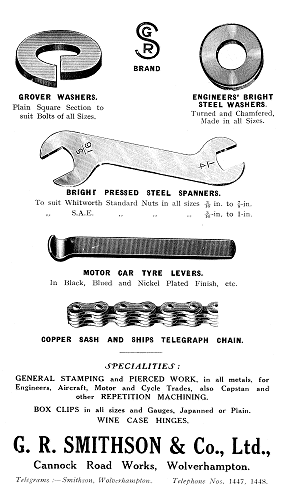
An advert from 1927. |
| A small
catalogue from the 1950s: |
|

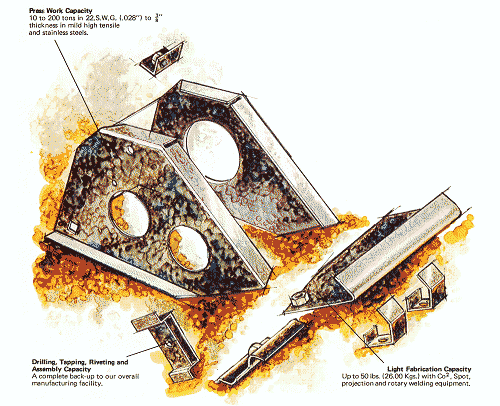
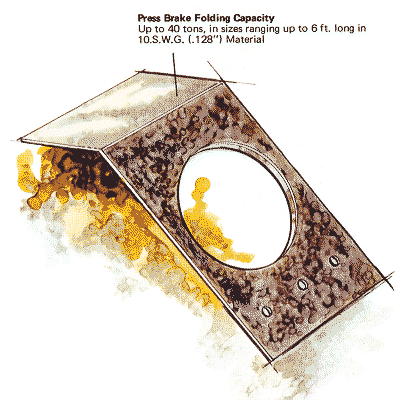

| For some years Smithsons also produced Carpenter
and Tildesley locks at the Cannock Road site, where
there was a lock making department.. In
1830, James Carpenter and John Young took out a
patent for an improved design of latch bolt and
lock. The two agreed to divide the patent into rim
lock use and mortice lock use. James Carpenter
constructed rim locks, while John Young had the
right to make mortice locks.
Carpenter named his rim lock "Number 60", which
became known as "Carpenters lift up lock". As his
business grew he erected a large factory in New
Road, Willenhall, known as Summerford Works. After
James's death in 1844, John Carpenter and James
Tildesley, a local locksmith who had married James’s
daughter Harriet, inherited the business. The name
was changed from Carpenter and Company to Carpenter
and Tildesley, in 1851.
In 1852 James Tildesley became the sole owner of
Carpenter and Tildesley and developed a large
business exporting locks to Australia. He died in
1876 and the control of Carpenter and Tildesley
passed to his sons, James C. and Clement.
James died in 1907, and in 1915 Clement signed a
lease with G. R. Smithson and Company Limited for
the lease of Summerford House, originally the home
of James Carpenter and then the Tildesleys. |
 |
Return to the Canals
and Industry Menu |
|